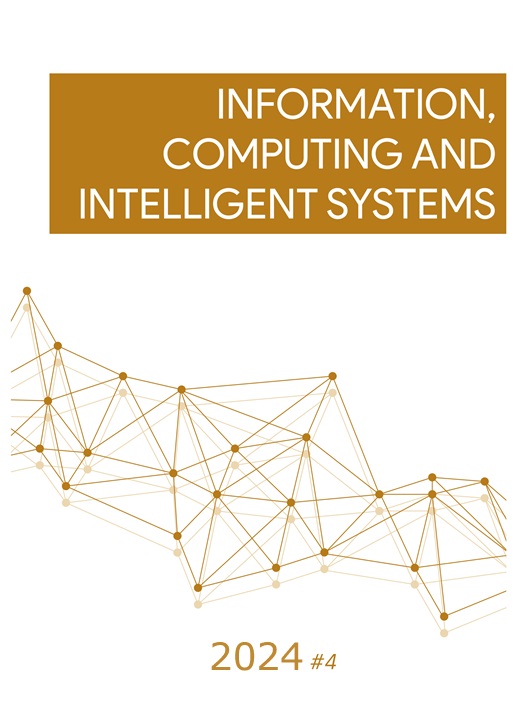Method of Dynamic Reconfiguration of Software-Configured Networks
DOI:
https://doi.org/10.20535/2786-8729.4.2024.305095Keywords:
Keywords: random graph, topology generation, SDNAbstract
The article presents a method of dynamic reconfiguration of a wireless software-configured network using random geometric intersection graphs.
Different implementations of SDN controllers have different characteristics, but despite the peculiarities of certain vendors, they can communicate with each other using the Openflow protocol. In the conditions of growth of various types of traffic and especially media, which is sensitive to delays, there is a problem in providing delay and speed indicators for data transmission channels.
The purpose of this study is to increase the fault tolerance of software-configured networks that use wireless communication methods. This will make it possible to continue data transmission and prevent information loss when certain communication channels are lost, or they are overloaded by other networks or means of influence.
The object of research is the process of generating the topology of a software-configured network using graph theory, namely, random geometric intersection graphs. Also, the object of the study is the impact of the wireless communication channel load on the quality characteristics of the data transmission channels.
To achieve the goal, the following tasks were set:
- analyze the methods of using different types of random graphs to generate the topology of software-configured networks. Determining the characteristics of graphs that affect network fault tolerance indicators.
- determine the influence of the wireless channel load indicator on the data transfer rate. Conduct research with different types of access point settings in IEEE 802.11 n, ac, ax protocols with different multi input multi output (MIMO) modes.
As a result of the study, the clustering coefficients were compared and an algorithm was developed for generating the topology for a software-configured network using random geometric intersection graphs. The impact of communication channel congestion in wireless networks was also investigated. MIMO has been found to affect network performance more than QAM and OFDMA.
The results of practical studies confirm the correctness of the selected methods for the reconfiguration of wireless SDN networks.
References
J. Alzarog, A. Almhishi, A. Alsunousi, A. Elasaifer, W. Eltarjaman, and S. O. Sati, “SDN Controllers Comparison Based On Network Topology,” in 2022 Workshop on Microwave Theory and Techniques in Wireless Communications (MTTW), IEEE, Oct. 2022, pp. 204–209. https://doi.org/10.1109/MTTW56973.2022.9942565.
S. M. Farhan and T. Chung, “Exploring the Evolution of TLS Certificates,” in Passive and Active Measurement, A. Brunstrom, M. Flores, and M. Fiore, Eds., Cham: Springer Nature Switzerland, 2023, pp. 71–84. https://doi.org/10.1007/978-3-031-28486-1_4.
L. Deri, M. Martinelli, T. Bujlow, and A. Cardigliano, “nDPI: Open-source high-speed deep packet inspection,” in 2014 International Wireless Communications and Mobile Computing Conference (IWCMC), 2014, pp. 617–622. https://doi.org/10.1109/IWCMC.2014.6906427.
Q. Wu, Q. Liu, Z. Jia, N. Xin, and T. Chen, “P4SQA: A P4 Switch-based QoS Assurance Mechanism for SDN,” IEEE Transactions on Network and Service Management, 2023, https://doi.org/10.1109/TNSM.2023.3280913.
S. Li, H. Yang, R. Gao, T. Jia, and H. Li, “Performance Analysis of QoS-Oriented OFDMA Protocol Based on IEEE 802.11ax for Cognitive Radio Network,” Applied Sciences (Switzerland), vol. 13, no. 12, Jun. 2023, https://doi.org/10.3390/app13127163.
A. Karakoç, H. B. Yilmaz, and M. Ş. Kuran, “More WiFi for everyone: Increasing spectral efficiency in WiFi6 networks using a distributed OBSS/PD mechanism,” Turkish Journal of Electrical Engineering and Computer Sciences, vol. 31, no. 3, pp. 660–677, 2023, https://doi.org/10.55730/1300-0632.4008.
T. Ropitault et al., “IEEE 802.11bf WLAN Sensing Procedure: Enabling the Widespread Adoption of WiFi Sensing,” IEEE Communications Standards Magazine, vol. 8, no. 1, pp. 58–64, Mar. 2024, https://doi.org/10.1109/MCOMSTD.0004.2200062.
E. N. Gilbert, “Random Graphs,” The Annals of Mathematical Statistics, vol. 30, no. 4, pp. 1141–1144, Dec. 1959, https://doi.org/10.1214/aoms/1177706098.
Q. Duchemin and Y. De Castro, “Random Geometric Graph: Some Recent Developments and Perspectives,” 2023, pp. 347–392. https://doi.org/10.1007/978-3-031-26979-0_14.
J. Dall and M. Christensen, “Random geometric graphs,” Phys Rev E, vol. 66, no. 1, p. 016121, Jul. 2002, https://doi.org/10.1103/PhysRevE.66.016121.
M. Deijfen and R. Michielan, “Geometric random intersection graphs with general connection probabilities,” Jun. 2023, https://doi.org/10.48550/arXiv.2306.17507.
Downloads
Published
How to Cite
Issue
Section
License
Copyright (c) 2024 Information, Computing and Intelligent systems

This work is licensed under a Creative Commons Attribution 4.0 International License.




